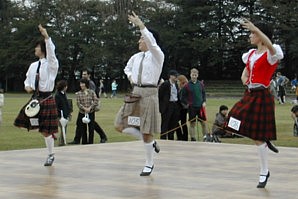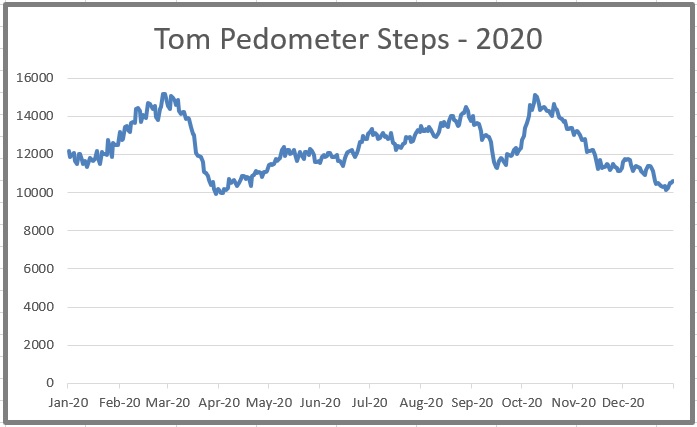
| Volume 37 #4 | January/February 2021 | |
We had a Zoomtastic time at the first-ever remotely-held Betwixt & Between Ceilidh on Tuesday, December 29th with participants from among our Southwest Washington and Oregon dancers, attended by folks from all over (including our daughter and her husband, Carolyn and Paul Tanner from San Jose, CA). Traditionally, we have gathered together between Christmas and New Year's Day to entertain each other with our homegrown talents, with some dancing added in. Our aim this year was to do the same, except that we wouldn't be able to dance.
Through the magic of green room video editing, we were serenaded by Patrick Hogan singing "Have Yourself a Very Merry Christmas," accompanied by Patrick on the piano and Patrick on the guitar, along with an electric guitar solo by special guest star, you guessed it, Patrick. (You can review that performance here.)
Kat and Rebecca Mintz told an original story called "Lucy Llama Rides Again". Kat told how Lucy kept herself busy and sane during a pandemic lock down, while Rebecca animated Lucy Llama and we acted out all the activities described.
Multi-talented Linda Mae's comedy video acted out the song "I Can't Dance" as the hilarious story of a very short, self-conscious boy trying to get up the courage to dance with a much taller self-conscious rake, er, girl. (You can review that performance here.)
Our poetry corner featured Paula Zellers' story of how WWI soldiers from opposing armies came together one Christmas eve to sing "Silent Night"; then Paula read a poem by a Scottish soldier who was there. To bring us back to silliness, John read the poem "Methuselah" (by the very prolific Anonymous) about eating large and living long.
We clapped and laughed along with Mel and Ken to "Long-legged Sailor", and then marveled at Liza's expressive reading of "Ladle Rat Rotten Hut". Few of us will forget the mural of that story!
We finished off with two a cappella videos:
Along with this shared talent, it was good to see so many familiar smiling faces, and to hear the laughter of friends. It helps tide us over until we will be dancing together again.
[Based on information contained in Surnames of Scotland by George Black. ~Mel]
Historically, people did not always have surnames but only a single personal name. The use of fixed or descriptive surnames appears to have commenced in France around the year 1000. Such names were introduced to Scotland through the Normans around 100 years later although the custom of using them wasn't common for many years.
In the reign of David I (1124-1153) surnames begin coming into wider use. During this time and successive reigns, the inhabitants of burgh towns were largely English or Flemish and the surnames reflected those languages (including Saxon). In contrast, the inhabitants of the countryside tended to have Gaelic names.
Many surnames have not survived. Events as the War of Independence (c. 1286-1320) resulted in large changes to families and property ownership and the erasure of names.
Surnames generally may be categorized as being 1) territorial (derived from possession or association with specific land); 2) descriptive (such as Henry Bald); 3) patronymic (derived from the name of a father or ancestor, typically by the addition of a prefix or suffix, for example Johnson, O'Brien); or 4) occupational.
Patronymic names proved popular, especially beginning in the 1300's. Sometimes, instead of using "son" as part of an offspring's name, the first name of the ancestor was adopted as the family surname instead. For example, a son of a man named "Andrew" may have been named Charlie Andrews instead of being named Andrewson. If an "s" appeared at the end (for example "Andrews"), the "s" was meant to represent "son."
Patronymics were not necessarily permanent and could change with each succeeding generation. For example, John Magnus' son could be called Magnus Johnson. Magnus Johnson in turn would name his son, John Magnus. This changing back and forth died out but still occurred into the eighteenth century in the Highlands and even into the first part of the nineteenth century in Shetland.
The great prevalence of certain surnames in small towns and villages led to the use of nicknames or "tee" names in order to distinguish between folks with the same names. Some examples found in such places as grocers' ledgers include Buckie, Beauty, Bam, the King, the Smack, Snipe, Toothie, Carrot, and Neep. These tees conjure up quite a picture of these Scots people, don't they?!
Then there is the matter of clan names. People would adopt as their surname, or even change an existing surname, to that of the clan that was currently in power in their locale. Sometimes a clan chief would mandate the name changes. These folks weren't kindred to the clan chief at all. This practice operated to reduce the number of Gaelic surnames in use.
Clan chiefs sometimes acted to increase the number of followers bearing their name through bribing poor parents with a "bow o' meal" to add the clan name to their child's name. People named in this process were sometimes referred to as, for example, "Frasers of the boll of meal" meaning that the Fraser name had been bestowed in this manner.
Regarding first or personal names, it was a not uncommon practice in the fourteenth to sixteenth centuries for two brothers to have the same first names. One theory for this was the custom of naming a child after each of its grandparents. And if both of these happened to have the same first name, the double naming was the result. Makes it pretty confusing for historians and genealogists!
Many old Gaelic personal names were taken from the names of animals associated with ferocity, strength or swiftness such as wolves and bears. Usually these names were compounded with another word or with a diminutive (for example, the name may have been wolfie instead of wolf). Color adjectives were often part of Gaelic names; Gaelic words for black, red, white, grey, blue were commonly used.
In the Hebrides, Norse names were translated into Gaelic, for example, Ivarsson became Maciver. Names could also be a fusion of the two languages, resulting in such interesting combinations as MacThorsteyn and MacTorfin.
Regarding those "mac" names, in general, the use of "Mac" was meant to mean "son of" when both the M and the first letter of the rest of the name was capitalized. For example, MacDonald would denote the son of Donald but Macdonald was a general surname and did not indicate precise parentage of the individual.
[This first appeared in the May/June 2003 issue of The Scottish Country Dancer, a nice reminder of the fun ahead! ~Ed.]
Eight hands round the plaidies go,
And back again on pointed toe.
Leading down and up again,
Skirted women and kilted men.
Cross at top to reels of three,
Back to own side, a whoop of glee.
Cast to bottom, right turn to end,
Our part is done, thank you, my friend.
[This article first appeared in the November/December 2002 issue of the Scottish Country Dancer~Ed.]
From October 4 through October 21, 2002, a group of Scottish Country Dancers lived the dance "Where East Meets West." The trip was arranged by Marge van Nus, who brought a similar group of dancers to Japan in 1991 and has been receiving invitations to repeat the process ever since.
 |
The group consisted of 14 dancers and one musician. In addition to Marge, eight other dancers from Vancouver USA Scottish Country Dancers went: Robert and Geri Stuart, John and Susan Shaw, Van Meter Hord, Raminta Soden, and Tom and Liza Halpenny. Melanie Plaut from Portland, Dixie Campbell from Estacada (our Cape Breton Dance soloist), Linda Danielson from Eugene (fiddler par excellence), Irene Paterson from Mukilteo, Bill Paterson from Friday Harbor, and Dave Wilson from Reno, NV, balanced out the team. With a variety of ages and experience, we had a good time getting to know each other. The lack of time practicing beforehand with team members from out of town added challenge to our adventure.
Traveling by train between cities and being housed in private homes offered us a unique view into the private lives of Japan. Our hosts spoke a wide variety of levels of English, but were always gracious and fed us royally. Team members spoke what little Japanese they could and did their best not to offend. Ask team members about electric toilets, green slippers, natto, ocha, and o-furos.
 |
The main cities visited were Ishioka, Chigasaki, Joyo (Vancouver's sister city), Ijira, and Kawasaki, where we met with each of the mayors. The group did twenty performances during the journey, including a competition dance and our homegrown "While You Were Gone" at the Tokyo Highland Games. We were highly impressed with the Japanese dancers' precision technique.
Most performances were in schools. Shy to join us at first in audience participation, the students invariably became in a frenzy to dance. It was a lot of fun to work with them, and touching to hear their speeches to us, which they stayed up all night practicing. Other dance venues were city halls, a shopping mall, and various intercultural parties put on by our host cities. Everywhere we danced, stayed, and visited, we were laden with gifts.
Without question, this trip was a life-altering experience for each of us--visiting a country very different from our own, working and playing with team members, and making new life-long Japanese friends. I hope every one of you gets to do something like this some day.
Happy New Year! I charted my 20-day-moving-average pedometer steps for 2020, averaging 12,300 steps per day. I had lots of folk dancing until Covid-19 arrived in March. After a month I learned how to resume dancing with online Zoom meetings through the spring and summer. The September wildfires smoke reduced activity, and I resumed in October then slowed down with less outdoor activity.

Calendar of Events | ||||||||||||||||||||||||||||||||||||||||||||||||||||||
|
|